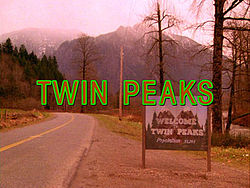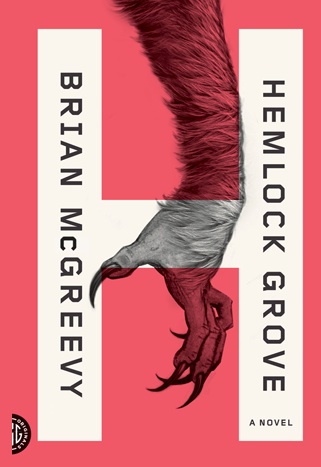I had just started reading Brian McGreevy’s Hemlock Grove when I spotted a news item about how Netflix had picked up a 13-episode series based on the novel, about a series of grisly murders in a Pennsylvania town and the unlikely team-up between Roman Godfrey, the teenage heir to what used to be the local steel fortune, and his classmate Peter Rumancek, a young Gypsy who could also be a werewolf. I wasn’t that deep into the novel, but I’d gotten far enough to think: Sure, I could see how this would work as television.
Hemlock Grove is, most assuredly, a horror novel for a generation that has always grown up not just under the influence of David Lynch, but with that influence firmly established—I don’t want to overstate the case by saying “taken for granted,” but I’m trying to place the far side of a transition point, the point after Blue Velvet and after Twin Peaks when there is very little if any confusion left in the mainstream culture as to what one means by “Lynchian.” So far past that point, really, that McGreevy doesn’t even have to be self-conscious about being Lynchian (although the novel is self-conscious in other regards). In fact, the further I got into Hemlock Grove, I found myself drawn not so much to the Lynchian flourishes, but to the underlying architecture that supports them.
Last summer, I wrote a post about Chinatown and the collision of genre, specifically that film’s mixture of noir and family melodrama. I talked about the melodrama as a genre of failed repression; the harder you try to cover up the sins or the traumas of the past, melodrama tells us, the more damage they will cause when they finally erupt. And these eruptions are not just dramatic, they are spectacularly dramatic—as the title of one classic 1950s film puts it, Larger Than Life. Extreme emotional outbursts, violent confrontations, shocking revelations: these are the basic components of the melodrama’s grammar.
In the classic melodrama, though, these disruptions of reality are still largely bounded by realist principles: The things people do and say to each other as these stories reach their climaxes may be extreme, but they are still possible. What if, though, the emotional distortions of the melodrama were mirrored by equally extreme distortions in the material world? We don’t have to imagine such a genre, because we already have the Gothic. And, in the world of television, we have Twin Peaks.
 While the specific ways in which Twin Peaks applied a Gothic sensibility to family melodrama were innovative, it wasn’t the first series to take that approach: Dark Shadows reveled in its supernatural trappings, even cranked them up to 11 in order to sustain interest in the perpetual narrative cycle. It’s become a cliché to say that the problem with Twin Peaks was that it took too long to tell us who killed Laura Palmer, but melodramatic repression does require release, and the longer that release is put off, the greater our expectations become for when it finally comes, perhaps with an increasing likelihood that we’ll find it anticlimactic, not really worth all that wait.
While the specific ways in which Twin Peaks applied a Gothic sensibility to family melodrama were innovative, it wasn’t the first series to take that approach: Dark Shadows reveled in its supernatural trappings, even cranked them up to 11 in order to sustain interest in the perpetual narrative cycle. It’s become a cliché to say that the problem with Twin Peaks was that it took too long to tell us who killed Laura Palmer, but melodramatic repression does require release, and the longer that release is put off, the greater our expectations become for when it finally comes, perhaps with an increasing likelihood that we’ll find it anticlimactic, not really worth all that wait.
(See, in this regard, many viewers’ thoughts about the final episodes of Lost.)
Hemlock Grove isn’t going to have that problem. As a novel, it has a reasonably firm narrative beginning and end, although it also drops enough clues to suggest the rich backstory before page 1 and leaves an opening in the final scenes just wide enough to suggest the possibility of more story to come. And as a television series, it benefits from one of the most significant developments in American TV in the two decades since Twin Peaks: the rise of alternatives to the open-ended format for prime time drama. The producers and writers won’t be forced to stall for time, putting off the resolution of Roman and Peter’s search for the killer, and they won’t be forced to come up with something even weirder once they do solve that mystery—although they’ll have the option of heading down that path if they think there’s enough money in it.
For me, the question is whether Hemlock Grove the TV series will take the opportunity it has to be as subversive about its melodramatic framework as Hemlock Grove the novel is. And by subversive, I don’t mean “camp.” I mean the ways in which Brian McGreevy imagines a world that has been warped by the scheming and betrayals of his characters, in which the fissures of repression take on increasingly unnatural qualities, and then invests this unnaturalness with a self-conscious seriousness—gently mocking at times, maybe, but never undercutting. Which is, in some ways, how the novel works its uncanniest effects. You know some of these flourishes are faintly ridiculous, and McGreevy knows you know, but you and he will agree to pretend to believe in them for the duration, and though he’ll remind you of that deal, he won’t rub your face in it—and that subtle acknowledgment of your sophistication will keep you engaged until the grand finale.
Check out an exclusive graphic novel prequel to Hemlock Grove here
Ron Hogan is the founding curator of Beatrice.com, one of the first websites to focus on books and authors. Lately, he’s been reviewing science fiction and fantasy for Shelf Awareness.










